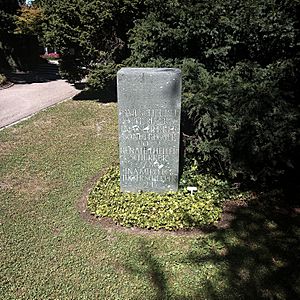Paul Scherrer facts for kids
Quick facts for kids
Paul Scherrer
|
|
|---|---|
 |
|
| Born |
Paul Hermann Scherrer
3 February 1890 |
| Died | 25 September 1969 (aged 79) Zurich, Switzerland
|
| Nationality | Swiss |
| Alma mater | Swiss Federal Polytechnic University of Göttingen |
| Known for | Debye–Scherrer method Scherrer equation |
| Awards | Marcel Benoist Prize (1943) |
| Scientific career | |
| Fields | Physicist |
| Institutions | ETH Zurich University of Göttingen |
| Doctoral advisor | Peter Debye |
| Doctoral students | Felix Boehm Egon Bretscher Hans Frauenfelder Bernd T. Matthias Julius Adams Stratton Fritz Zwicky |
Paul Hermann Scherrer (born February 3, 1890 – died September 25, 1969) was a famous Swiss physicist. He was born in St. Gallen, Switzerland. He studied in Göttingen, Germany, and later became a professor at ETH Zurich, a top university in Switzerland.
Contents
Early Life and Discoveries
Paul Scherrer was born in St. Gallen. In 1908, he started studying at the Swiss Federal Polytechnic. After two semesters, he decided to switch from Botany to Mathematics and Physics.
Studying the Faraday Effect
In 1912, Scherrer continued his studies at the University of Göttingen. He earned his doctorate there, focusing on the Faraday Effect in the hydrogen molecule. The Faraday Effect describes how a magnetic field can affect light passing through a material.
The Debye–Scherrer Method
In 1916, while still working on his studies, Paul Scherrer and his teacher, Peter Debye, created something very important. They developed the "Debye–Scherrer powder method." This method uses X-rays to study the structure of tiny crystals. It was a big step forward for understanding how materials are built at a very small level. This method is still used today in large science facilities like the Paul Scherrer Institute. Peter Debye later won the Nobel Prize for chemistry in 1936 for this kind of work.
Understanding Crystal Size
Paul Scherrer is also well-known for figuring out how the width of an X-ray diffraction peak relates to the size of a crystal. He published this important discovery in 1918. This relationship is now known as the Scherrer equation.
Becoming a Professor
In 1920, when he was only 30 years old, ETH Zurich made Scherrer a Professor of Experimental Physics. In 1925, he helped organize the first international meeting for physicists after the First World War. He became the head of the Physical Institute at ETH in 1927. He guided the institute to focus on nuclear physics, which was a very new field at the time. Under his leadership, the first cyclotron (a type of particle accelerator) at ETH Zurich was built in 1940.
Contributions to Nuclear Science
Paul Scherrer played a key role in the development of nuclear science in Switzerland.
Helping the United States
During World War II, starting in late 1944, Scherrer shared information with the United States about German scientists and their efforts to develop a nuclear weapon. He did this through a person named Moe Berg.
Switzerland's Nuclear Program
After the war, Scherrer became a strong supporter of Switzerland developing its own nuclear weapons. This program was actively pursued by the Swiss government for 43 years. It was finally stopped in 1988.
Leading Nuclear Committees
Besides his research, Paul Scherrer served on several important committees in Switzerland. In 1946, the Swiss Federal Council made him the President of the Swiss Study Commission on Atomic Energy. In 1958, he became President of the Swiss Commission for Atomic Sciences.
Founding CERN
Scherrer also helped establish CERN (the European Organization for Nuclear Research) near Geneva between 1952 and 1954. When CERN was created, he became one of the first members of its Scientific Policy Committee and the CERN Council. He also helped set up Reaktor AG, a company that studied how to build and operate nuclear fission facilities.
Impact on Swiss Research
Paul Scherrer's vision helped new areas of physics grow in Switzerland. These included solid-state physics, particle physics, and electronics. His work greatly improved the quality of research at Swiss universities. He retired from ETH Zurich in 1960 after 40 years. After retiring, he continued teaching at the University of Basel.
Personal Life
In 1922, Paul Scherrer married Ina Sonderegger. They had two daughters together. He passed away on September 25, 1969, after a horse-riding accident.
Legacy and Recognition
Paul Scherrer Institute
The Paul Scherrer Institute (PSI), a major research center in Switzerland, is named after him. It was created on January 1, 1988. This happened when two older institutes, the Federal Institute for Reactor Research (EIR) and the Swiss Institute for Nuclear Physics (SIN), merged.
Route Scherrer at CERN
There is a street at CERN in Geneva, Switzerland, named Route Scherrer, in his honor.
Images for kids
See also
 In Spanish: Paul Scherrer para niños
In Spanish: Paul Scherrer para niños




